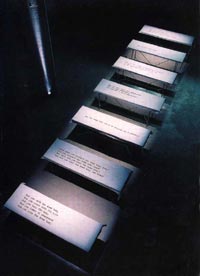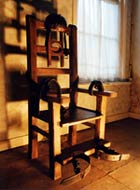
|
||||||||
|
|
Poetry in Art
|
|
|
| Face the Dead |
 photography by Bob van Zahn |
The Poem Death (1997) by Harold Pinter silkscreen on 7 hospital bed sheets / 7 forensic dissection tables, surrounded by the smell of lysol George M. Tokaya 2000 This installation by the Indonesian/Dutch artist George M Tokaya Death (Births and Deaths Registration Act 1953) Where was the body found? Who was the dead body? Who was the father or daughter or brother |
|
|
Was the body dead when abandoned? Was the dead body naked or dressed for a journey? What made you declare the dead body dead? Did you wash the dead body George Tokaya's installation was first presented at the 'Pinter in London' convention, London June 2000. About the artist and his work: (adapted from
a text by the Project bureau Academie Minerva) The poem Death (Births and Deaths Registration Act 1953) of 1997 forces us to face the dead. In Harold Pinter's words: 'Do the structures of language and the structures of reality (by which I mean what actually happens) move along parallel lines? Does reality essentially remain outside language, separate, obdurate, alien, vital correspondence between what is-to distort what happens-because we fear it? We can't face the dead. But we must face the dead, because they die in our name. We must pay attention to what is being done in our name. I believe it's because of the way we use language that we have got ourselves into this terrible trap'.
Current Revenge (2000) By George Tokaya in response to Poem Don't Look (1995) currently on exhibition 3 February - 4 March 2001 in The Netherlands at Borg Rusthoven, Rijksweg 39, 9971 PT Wirdum. For information and appointments telephone + 31 (0)596 572762 |

 The
questions in the poem are inevitable for Tokaya. As inescapable
as the inevitability of death. The word 'inevitability' is a key
for the choice of strong images, such as hospital bed sheets and
forensic dissection tables surrounded by the smell of the cleaning
liquid lysol. In a repeated motion, as in the poem, it creates
almost a tautology comparable to the absurdity of war and cruelty.
The
questions in the poem are inevitable for Tokaya. As inescapable
as the inevitability of death. The word 'inevitability' is a key
for the choice of strong images, such as hospital bed sheets and
forensic dissection tables surrounded by the smell of the cleaning
liquid lysol. In a repeated motion, as in the poem, it creates
almost a tautology comparable to the absurdity of war and cruelty.